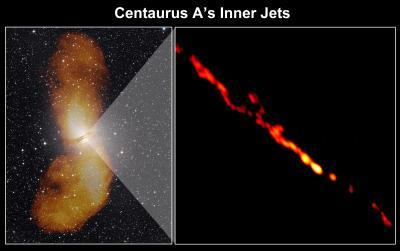An international team, including NASA-fundedresearchers, using radio telescopes located throughout the SouthernHemisphere has produced the most detailed image of particle jetserupting from a supermassive black hole in a nearby galaxy.
"These jets arise as infalling matter approaches the black hole, butwe don't yet know the details of how they form and maintainthemselves," said Cornelia Mueller, the study's lead author and adoctoral student at the University of Erlangen-Nuremberg in Germany.
The new image shows a region less than 4.2 light-years across -- lessthan the distance between our sun and the nearest star.Radio-emitting features as small as 15 light-days can be seen, makingthis the highest-resolution view of galactic jets ever made. Thestudy will appear in the June issue of Astronomy and Astrophysics andis available online.
Mueller and her team targeted Centaurus A (Cen A), a nearby galaxywith a supermassive black hole weighing 55 million times the sun'smass. Also known as NGC 5128, Cen A is located about 12 millionlight-years away in the constellation Centaurus and is one of thefirst celestial radio sources identified with a galaxy.
Seen in radio waves, Cen A is one of the biggest and brightest objectsin the sky, nearly 20 times the apparent size of a full moon. This isbecause the visible galaxy lies nestled between a pair of giantradio-emitting lobes, each nearly a million light-years long.
These lobes are filled with matter streaming from particle jets nearthe galaxy's central black hole. Astronomers estimate that matter

Merging X-ray data (blue) from NASA's Chandra X-ray Observatory with microwave (orange) and visible images reveals the jets and radio-emitting lobes emanating from Centaurus A's central black hole.
(Photo Credit: ESO/WFI (visible); MPIfR/ESO/APEX/A.Weiss et al. (microwave); NASA/CXC/CfA/R.Kraft et al. (X-ray))
near the base of these jets races outward at about one-third thespeed of light.
Using an intercontinental array of nine radio telescopes, researchersfor the TANAMI (Tracking Active Galactic Nuclei with AustralMilliarcsecond Interferometry) project were able to effectively zoominto the galaxy's innermost realm.
"Advanced computer techniques allow us to combine data from theindividual telescopes to yield images with the sharpness of a singlegiant telescope, one nearly as large as Earth itself," said RoopeshOjha at NASA's Goddard Space Flight Center in Greenbelt, Md.
The enormous energy output of galaxies like Cen A comes from gasfalling toward a black hole weighing millions of times the sun'smass. Through processes not fully understood, some of this infallingmatter is ejected in opposing jets at a substantial fraction of thespeed of light. Detailed views of the jet's structure will helpastronomers determine how they form.
The jets strongly interact with surrounding gas, at times possiblychanging a galaxy's rate of star formation. Jets play an importantbut poorly understood role in the formation and evolution ofgalaxies. NASA's Fermi Gamma-ray Space Telescope has detected muchhigher-energy radiation from Cen A's central region.
"This radiation is billions of times more energetic than the radiowaves we detect, and exactly where it originates remains a mystery,"said Matthias Kadler at the University of Wuerzburg in Germany and acollaborator of Ojha. "With TANAMI, we hope to probe the galaxy'sinnermost depths to find out."

Left: The giant elliptical galaxy NGC 5128 is the radio source known as Centaurus A. Vast radio-emitting lobes (shown as orange in this optical/radio composite) extend nearly a million light-years from the galaxy. Credit: Capella Observatory (optical), with radio data from Ilana Feain, Tim Cornwell, and Ron Ekers (CSIRO/ATNF), R. Morganti (ASTRON), and N. Junkes (MPIfR). Right: The radio image from the TANAMI project provides the sharpest-ever view of a supermassive black hole's jets. This view reveals the inner 4.16 light-years of the jet and counterjet, a span less than the distance between our sun and the nearest star. The image resolves details as small as 15 light-days across. Undetected between the jets is the galaxy's 55-million-solar-mass black hole.
(Photo Credit: : NASA/TANAMI/Müller et al.)
Source: NASA/Goddard Space Flight Center